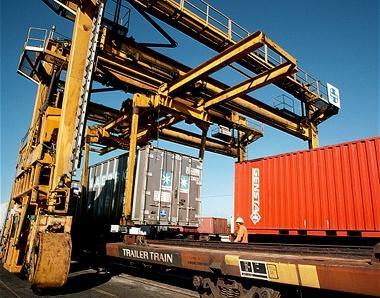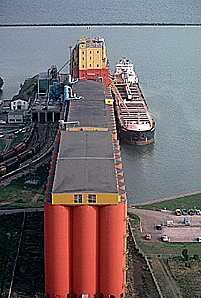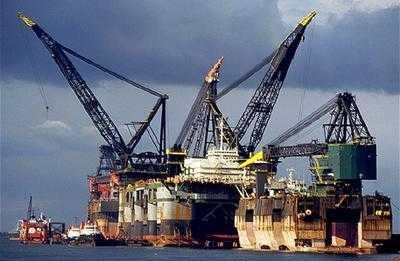When a ship reaches port, it may be assigned a berth, which is a mooring space along a wharf or a pier. A wharf--sometimes called a quay (pronounced kE)--lies parallel to the shore. A pier projects lengthwise into the harbour.

Solid bulk cargoes, such as coal and limestone, are generally loaded from shoreside stockpiles to ships by means of conveyor belts. Iron ore is usually loaded from ore docks. These are elevated railways with chutes which drop the ore into the holds of waiting ships. Grain is loaded through chutes from dockside or from floating elevators. The unloading of solid bulk cargoes is often done with mechanised shovels or by conveyor systems. Large "vacuum cleaners" are frequently used to unload grain, copra, and similar bulk cargoes. Liquid bulk cargoes are pumped through hose between shoreside storage tanks and ships.
Transit sheds on a pier or wharf provide storage for general cargo. The men who do the work of loading or unloading general cargo are called longshoremen or stevedores. General cargo is usually handled by means of winches on the ship's deck. Items of cargo that weigh hundreds of tons, however, are customarily handled by means of a dockside crane or by a crane floated on a barge next to the ship. Dockside gantry cranes transfer semitrailer-size cargo containers to and from container ships.

Ports situated on open roadstead harbours are often too shallow to permit ocean-going ships to reach shoreside installations. The transfer of cargo and passengers to and from such ships must be done by means of shallow-draft lighters, which shuttle back and forth to shore. Some ports have been constructed on artificial islands supported on stilts.
All large ports have dry docks and other facilities for repairing ships. Dry docks are of two types-->graving docks and floating dry docks. A graving dock is a concrete basin that can be closed with watertight gates after a ship has entered. The water is pumped out or allowed to run out with the tide, the ship being held upright by timbers. This facilitates the repair of parts of the vessel that are normally underwater. A floating dry dock is mobile. It can be submerged or raised by increasing or decreasing the amount of water within its hollow side walls, and it can be taken wherever it is needed--across oceans if necessary.

The planning of harbours and ports, whether for transportation, reclamation, or conservancy, has recently included the use of model studies. Once regarded as scientific toys, scale models of harbours, ports, and the surrounding areas are in many instances essential to any large-scale redevelopment of a coastal area and are useful even for minor modifications or additions. These models are made so that water can be caused to flow in such a way as to reproduce the various tidal and wave effects of the existing coastal system.
In the United States, harbour maintenance and the operation of port facilities are the responsibilities of several federal and local government agencies. The port authority assigns berthing and anchorage space to ships. It also operates cargo and passenger terminals. Some large harbours that include the port facilities of several municipalities are under the jurisdiction of a single port authority. The Port Authority of New York and New Jersey is an example.

Rotterdam is the world's busiest port. The city's centre was devastated by German and Allied bombing during World War II. Its development was favoured by its commercially strategic location on the Rhine River delta--some 15 miles from the North Sea.
Today most cargo entering Rotterdam from the sea--by way of a ship canal--passes on to Europe's interior. Much of the city's industry centres upon petroleum, which constitutes about half of Rotterdam's imports. Other major imports are iron ore, coal, and wheat. Exports include manufactured goods and chemical products.
In the 1950s a complex of port installations and related industrial facilities--known collectively as the Botlek --was set up to handle the growing needs of the European Economic Community as well as of The Netherlands itself. Today a much larger complex, called Europort, consists of industrial sites and harbour basins. It handles chiefly vessels too large to reach Rotterdam, including oil tankers and iron ore bulk carriers. (See also Rotterdam.)
Once the busiest port in the world, the Port of New York remains one of the major ports of the Western Hemisphere. It is located at the mouth of the Hudson River in New York City and is the largest port in the United States, handling about one tenth of all of the country's imports. It is also one of the best natural harbours in the world. It is deep and well sheltered, and the rise and fall of the tide is relatively small. In addition, it can accommodate an almost unlimited amount of traffic.

The Port of New York encompasses all waterways and port facilities within a 25-mile radius of the Statue of Liberty. The port's total frontage along navigable waters is 751 miles. There are more than 250 berths for deep-draft general cargo vessels. In one year nearly 100 million tons of coastal and foreign cargo are handled. Foreign-trade cargo predominates.
The Port Authority of New York has jurisdiction over marine cargo terminals, marine passenger terminals, heliports, and four airports: John F. Kennedy International Airport and LaGuardia Airport in New York and Newark Airport and Teterboro Airport in New Jersey.
On the East coast of the United States other major ports are Hampton Roads, Va.; Baltimore, Md.; and Philadelphia, Pa. The significant ports on the Gulf coast are New Orleans, La., and Houston, Tex. The two chief ports on the Pacific coast are Oakland and Los Angeles, Calif. The busiest ports on the Great Lakes are Chicago; Detroit, Mich.; Toledo, Ohio; and Duluth, Minn.-Superior, Wis.
Canada's chief Pacific seaport in terms of traffic and cargo turnover is Vancouver, B.C. Its most significant ports on the Atlantic coast are Montreal, Que., and Halifax, N.S. On the Great Lakes, Toronto and Thunder Bay, Ont., handle large amounts of tonnage annually.

London, England, which for years had been Europe's leading seaport, continues to rank as one of the world's foremost shipping centres. Milford-Haven and Southampton are also among the world's leading seaports. Hamburg and Bremen, Germany, are not far behind Rotterdam as European centres of waterborne commerce.
The two leading ports of South America, in terms of cargo turnover, are located in Argentina--Santos and Buenos Aires. Asia's major ports include Hong Kong; Singapore; and Chiba and Yokohama, Japan. Africa's port with high-tonnage turnover is Casablanca, Morocco.